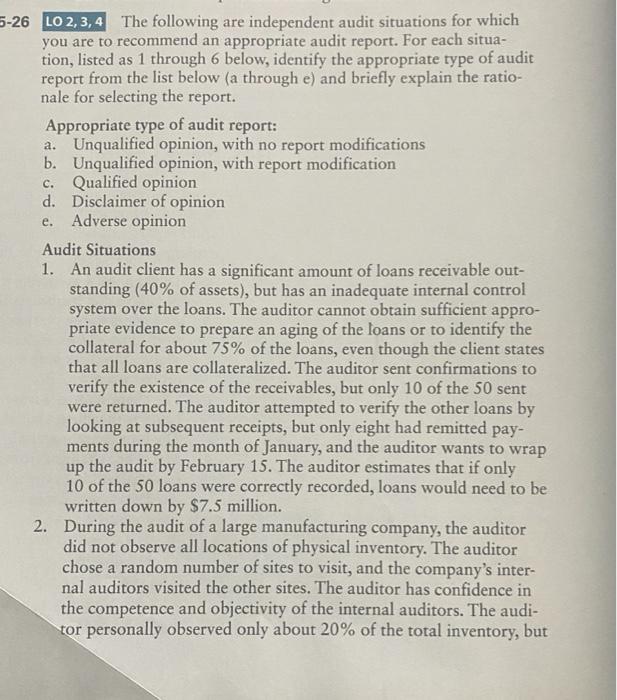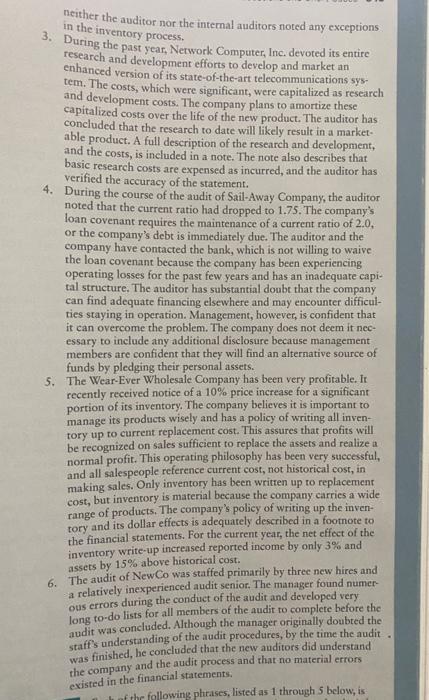e. 5-26 LO 2,3,4 The following are independent audit situations for which you are to recommend an appropriate audit report. For each situa- tion, listed as 1 through 6 below, identify the appropriate type of audit report from the list below (a through e) and briefly explain the ratio- nale for selecting the report. Appropriate type of audit report: a. Unqualified opinion, with no report modifications b. Unqualified opinion, with report modification c. Qualified opinion d. Disclaimer of opinion Adverse opinion Audit Situations 1. An audit client has a significant amount of loans receivable out- standing (40% of assets), but has an inadequate internal control system over the loans. The auditor cannot obtain sufficient appro- priate evidence to prepare an aging of the loans or to identify the collateral for about 75% of the loans, even though the client states that all loans are collateralized. The auditor sent confirmations to verify the existence of the receivables, but only 10 of the 50 sent were returned. The auditor attempted to verify the other loans by looking at subsequent receipts, but only eight had remitted pay- ments during the month of January, and the auditor wants to wrap up the audit by February 15. The auditor estimates that if only 10 of the 50 loans were correctly recorded, loans would need to be written down by $7.5 million. 2. During the audit of a large manufacturing company, the auditor did not observe all locations of physical inventory. The auditor chose a random number of sites to visit, and the company's inter- nal auditors visited the other sites. The auditor has confidence in the competence and objectivity of the internal auditors. The audi- tor personally observed only about 20% of the total inventory, but in the inventory process. neither the auditor nor the internal auditors noted any exceptions 3. During the past year, Network Computer, Inc. devoted its entire research and development efforts to develop and market an enhanced version of its state-of-the-art telecommunications sys tem. The costs, which were significant, were capitalized as research and development costs. The company plans to amortize these capitalized costs over the life of the new product. The auditor has concluded that the research to date will likely result in a market- able product. A full description of the research and development, and the costs, is included in a note. The note also describes that basic research costs are expensed as incurred, and the auditor has verified the accuracy of the statement. 4. During the course of the audit of Sail-Away Company, the auditor noted that the current ratio had dropped to 1.75. The company's loan covenant requires the maintenance of a current ratio of 2.0. or the company's debt is immediately due. The auditor and the company have contacted the bank, which is not willing to waive the loan covenant because the company has been experiencing operating losses for the past few years and has an inadequate capi- tal structure. The auditor has substantial doubt that the company can find adequate financing elsewhere and may encounter difficul- ties staying in operation. Management, however, is confident that it can overcome the problem. The company does not deem it nec essary to include any additional disclosure because management members are confident that they will find an alternative source of funds by pledging their personal assets. 5. The Wear-Ever Wholesale Company has been very profitable. It recently received notice of a 10% price increase for a significant portion of its inventory. The company believes it is important to manage its products wisely and has a policy of writing all inven- tory up to current replacement cost. This assures that profits will be recognized on sales sufficient to replace the assets and realize a normal profit. This operating philosophy has been very successful and all salespeople reference current cost, not historical cost, in making sales. Only inventory has been written up to replacement cost, but inventory is material because the company carries a wide range of products. The company's policy of writing up the inven- tory and its dollar effects is adequately described in a footnote to the financial statements. For the current year, the net effect of the inventory write-up increased reported income by only 3% and assets by 15% above historical cost. 6. The audit of NewCo was staffed primarily by three new hires and a relatively inexperienced audit senior. The manager found numer ous errors during the conduct of the audit and developed very long to-do lists for all members of the audit to complete before the audit was concluded. Although the manager originally doubted the staff's understanding of the audit procedures, by the time the audit was finished, he concluded that the new auditors did understand the company and the audit process and that no material errors existed in the financial statements, of the following phrases, listed as 1 through 5 below, is e. 5-26 LO 2,3,4 The following are independent audit situations for which you are to recommend an appropriate audit report. For each situa- tion, listed as 1 through 6 below, identify the appropriate type of audit report from the list below (a through e) and briefly explain the ratio- nale for selecting the report. Appropriate type of audit report: a. Unqualified opinion, with no report modifications b. Unqualified opinion, with report modification c. Qualified opinion d. Disclaimer of opinion Adverse opinion Audit Situations 1. An audit client has a significant amount of loans receivable out- standing (40% of assets), but has an inadequate internal control system over the loans. The auditor cannot obtain sufficient appro- priate evidence to prepare an aging of the loans or to identify the collateral for about 75% of the loans, even though the client states that all loans are collateralized. The auditor sent confirmations to verify the existence of the receivables, but only 10 of the 50 sent were returned. The auditor attempted to verify the other loans by looking at subsequent receipts, but only eight had remitted pay- ments during the month of January, and the auditor wants to wrap up the audit by February 15. The auditor estimates that if only 10 of the 50 loans were correctly recorded, loans would need to be written down by $7.5 million. 2. During the audit of a large manufacturing company, the auditor did not observe all locations of physical inventory. The auditor chose a random number of sites to visit, and the company's inter- nal auditors visited the other sites. The auditor has confidence in the competence and objectivity of the internal auditors. The audi- tor personally observed only about 20% of the total inventory, but in the inventory process. neither the auditor nor the internal auditors noted any exceptions 3. During the past year, Network Computer, Inc. devoted its entire research and development efforts to develop and market an enhanced version of its state-of-the-art telecommunications sys tem. The costs, which were significant, were capitalized as research and development costs. The company plans to amortize these capitalized costs over the life of the new product. The auditor has concluded that the research to date will likely result in a market- able product. A full description of the research and development, and the costs, is included in a note. The note also describes that basic research costs are expensed as incurred, and the auditor has verified the accuracy of the statement. 4. During the course of the audit of Sail-Away Company, the auditor noted that the current ratio had dropped to 1.75. The company's loan covenant requires the maintenance of a current ratio of 2.0. or the company's debt is immediately due. The auditor and the company have contacted the bank, which is not willing to waive the loan covenant because the company has been experiencing operating losses for the past few years and has an inadequate capi- tal structure. The auditor has substantial doubt that the company can find adequate financing elsewhere and may encounter difficul- ties staying in operation. Management, however, is confident that it can overcome the problem. The company does not deem it nec essary to include any additional disclosure because management members are confident that they will find an alternative source of funds by pledging their personal assets. 5. The Wear-Ever Wholesale Company has been very profitable. It recently received notice of a 10% price increase for a significant portion of its inventory. The company believes it is important to manage its products wisely and has a policy of writing all inven- tory up to current replacement cost. This assures that profits will be recognized on sales sufficient to replace the assets and realize a normal profit. This operating philosophy has been very successful and all salespeople reference current cost, not historical cost, in making sales. Only inventory has been written up to replacement cost, but inventory is material because the company carries a wide range of products. The company's policy of writing up the inven- tory and its dollar effects is adequately described in a footnote to the financial statements. For the current year, the net effect of the inventory write-up increased reported income by only 3% and assets by 15% above historical cost. 6. The audit of NewCo was staffed primarily by three new hires and a relatively inexperienced audit senior. The manager found numer ous errors during the conduct of the audit and developed very long to-do lists for all members of the audit to complete before the audit was concluded. Although the manager originally doubted the staff's understanding of the audit procedures, by the time the audit was finished, he concluded that the new auditors did understand the company and the audit process and that no material errors existed in the financial statements, of the following phrases, listed as 1 through 5 below, is








